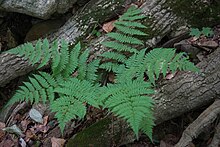Dryopteris carthusiana is a perennial species of fern native to damp forests throughout the Holarctic Kingdom. It is known as the narrow buckler-fern in the United Kingdom,[2] and as the spinulose woodfern in North America.[3]
| Dryopteris carthusiana | |
|---|---|

| |
| Growing in Pennsylvania | |
| Scientific classification | |
| Kingdom: | Plantae |
| Clade: | Tracheophytes |
| Division: | Polypodiophyta |
| Class: | Polypodiopsida |
| Order: | Polypodiales |
| Suborder: | Polypodiineae |
| Family: | Dryopteridaceae |
| Genus: | Dryopteris |
| Species: | D. carthusiana
|
| Binomial name | |
| Dryopteris carthusiana | |
| Synonyms | |
| |
It is a tetraploid of hybrid origin, one parent being Dryopteris intermedia, known in North America as the intermediate wood fern, and an unknown, apparently extinct species dubbed Dryopteris semicristata, which is also the presumed parent of the hybrid-origin Dryopteris cristata.
This plant is toxic.[4]

Description edit
This dark green plant is upright-ish, growing in leaf bunches, with wide leaves. It has a short rootstock. The leaves are upright in sparse-ish bunches and overwintering, 30-50 cm. The leaf stalk is about the length of the leaf blade and light-brown scaled. The leaf blade is narrowly ovate double pinnate. The leaflets are narrowly triangular. The sporangium are located on the underside of the leaves in round kidney-like sori.[4]
This fern is often confused with several other wood fern species, including D. intermedia, D. campyloptera, and D. expansa. It especially extensively shares the range of D. intermedia, but the two may be distinguished by the innermost pinnule on the bottom side of the bottom pinna: this pinnule is longer than the adjacent pinnules in D. carthusiana, but shorter or even in D. intermedia. D. carthusiana is a sub-evergreen species, its fronds surviving mild winters but dying back in harsh winters.
Habitat edit
The plant favors acidic ground and even avoids lime rich soil and spring areas favored by many other pteridophyta. It can tolerate direct sunlight slightly better than its relatives and can therefore survive even in some logging sites and benefit from them. It grows often in the following habitats: moist depressions in forests, nemoral forests, coastal scrubs, fresh cliff faces, sides of ditches, coniferous swamps and herb-rich hardwood-spruce swamps (ruohokorpi in Finnish).[4]
It is known to be able to use artificial light to grow in places which are otherwise devoid of natural light, such as Niagara Cave.[5]
References edit
- ^ NatureServe (2 June 2023). "Dryopteris carthusiana". NatureServe Network Biodiversity Location Data accessed through NatureServe Explorer. Arlington, Virginia: NatureServe. Retrieved 6 June 2023.
- ^ BSBI List 2007 (xls). Botanical Society of Britain and Ireland. Archived from the original (xls) on 2015-06-26. Retrieved 2014-10-17.
- ^ USDA PLANTS Profile
- ^ a b c Piirainen, Mikko; Piirainen, Pirkko; Vainio, Hannele (1999). Kotimaan luonnonkasvit [Native wild plants] (in Finnish). Porvoo, Finland: WSOY. p. 32. ISBN 951-0-23001-4.
- ^ Thatcher, Edward P. (1947). "Observations on Bryophytes Living in an Artificially Illuminated Limestone Cave". The American Midland Naturalist. 37 (3): 797–800. doi:10.2307/2421476. JSTOR 2421476.
Further reading edit
- Rünk, Kai; Zobel, Martin; Zobel, Kristjan (2012). "Biological Flora of the British Isles: Dryopteris carthusiana, D. dilatata and D. expansa". Journal of Ecology. 100 (4): 1039–1063. doi:10.1111/j.1365-2745.2012.01985.x.
